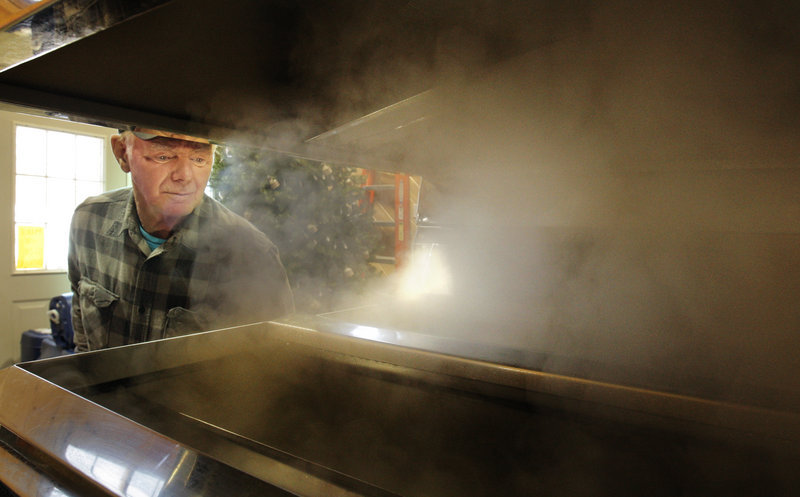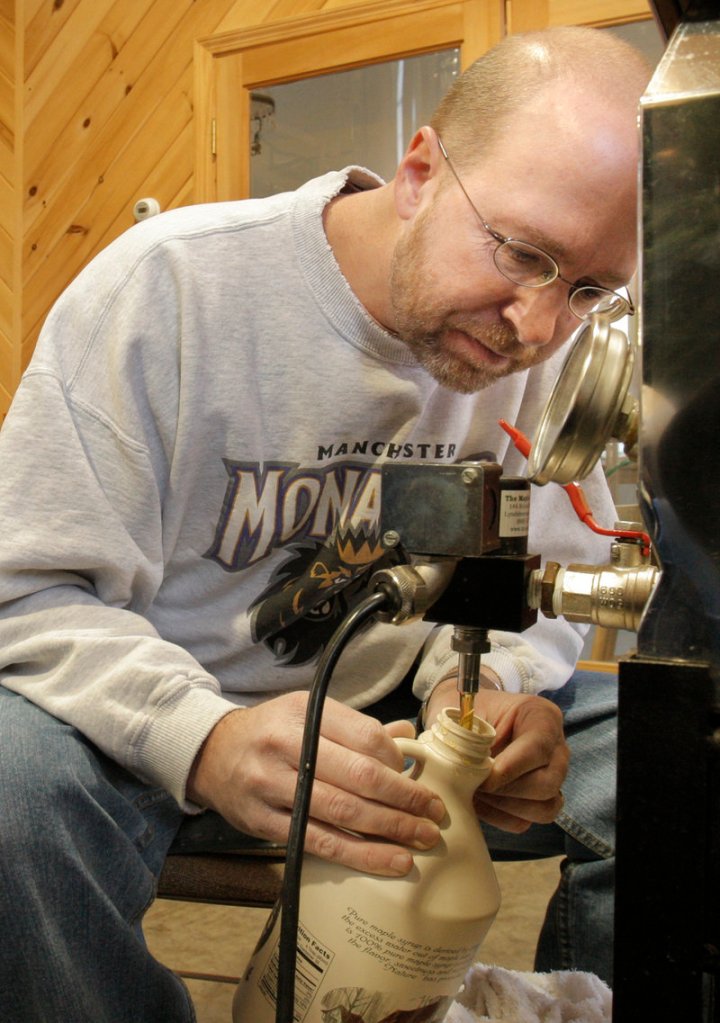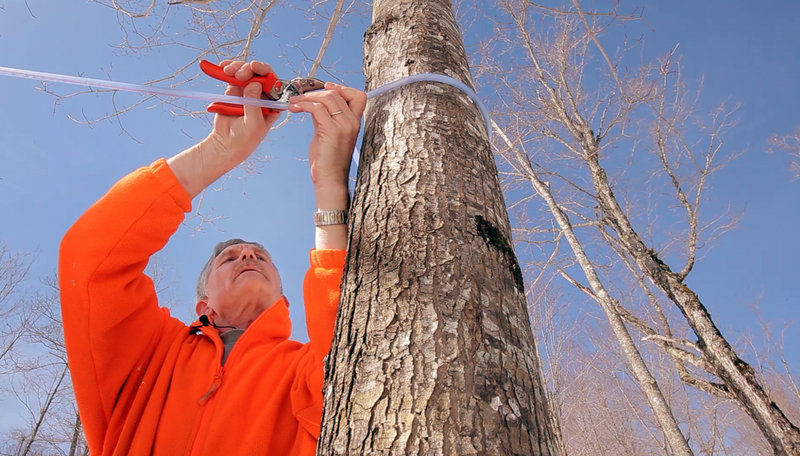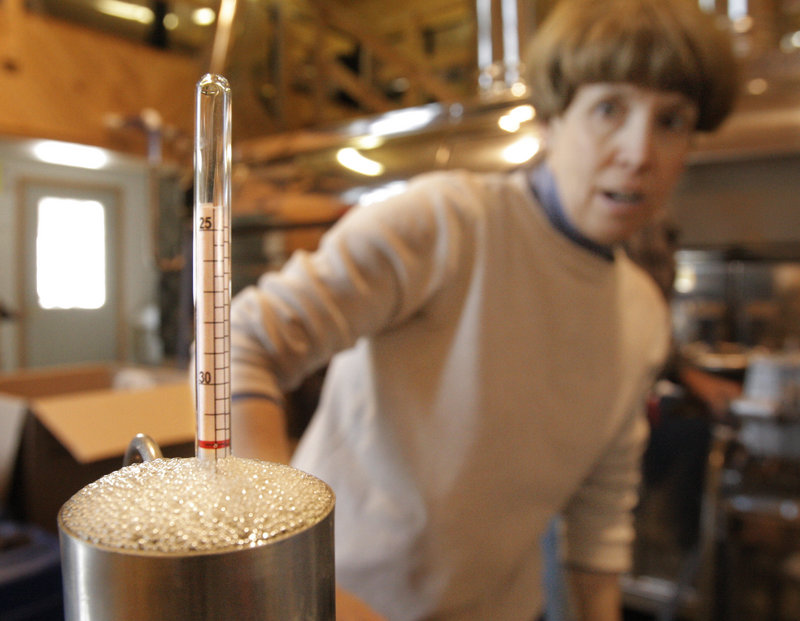NEWFIELD – Harry Hartford starts to look puzzled as he gazes at a pressure gauge on a piece of machinery — an extractor — that is pulling in sap from some 1,600 maple trees scattered over his 45-acre property.
The pressure is not what it was yesterday, and Harry estimates that his extractor might be pulling in only half as much sap. So he starts opening and closing valves that control the various lines, blue plastic tubing that crisscrosses his land and carries sap from every tap to his sugarhouse.
But it’s no use; he can’t seem to isolate the problem.
“We’re going to have to go out and walk the lines to find out what the problem is,” said Harry, 61, a retired physics teacher who opened the Thurston and Peters Sugarhouse in 2007 with his wife, Debra. “That’s how we spend a lot of our time — out on the lines, looking and listening.”
Listening, Harry told me, for leaks. You can literally hear the air rushing into the lines as a vacuum pump sucks the sap to the sugarhouse.
Walking out in the scenic countryside in Newfield doesn’t sound all that bad to me. But when I looked out the sugarhouse window, I saw that there was still almost 2 feet of snow on the ground, and that most of the trees were on the side of steep Bond Mountain, which rises from the sugarhouse on Route 11 some 800 to 900 feet.
So walking the lines meant putting on snowshoes (which I had never done before) and climbing the hill on a bed of soft snow while ducking under the plastic sap lines.
Debra helped me fasten the snowshoes. Then she loaded me down with an apron full of the tools she uses when looking to do repairs on the lines, including a wood hammer, several cutters and replacement taps and tubing.
I followed Harry up the hill for just a few minutes before one snowshoe came off. A few minutes later, the other.
KEEPING THINGS FLOWING
At a couple of points, we just stopped and listened for hissing air made by leaks. We didn’t hear any, so we walked from tree to tree looking for leaks.
A couple of trees had taps that seemed to be jutting out of the tree a little too much — this can be caused by cold temperatures. So I tapped them in with my hammer. Sometimes, they were over my head.
We didn’t find any leaks, but we didn’t search the entire hillside, as the Hartfords often do, so we went back to the sugarhouse, where Debra was preparing to boil sap into syrup.
When we told Debra we didn’t find the leak, she said, “I know what I’m doing later today.” She considers scouring the hillside for leaks and repairs to be a perk of the job — a built-in exercise program.
“I call it my StairMaster,” she said. “That’s where the real work is — out there. If not for what we have out there, we wouldn’t have anything to make syrup with in here.”
As Debra fired up a large oil-powered evaporator (the boiler, in common sugarhouse parlance), her husband began to explain all its parts and how it works in much more detail than I can relate. Basically, the giant stainless-steel contraption had sap flowing first into a preheating area, then into a “flue pan” area, then into the finishing area before it is ready for packaging.
As the evaporator begins heating up, Debra runs around checking temperatures at various stages and peeking into the boiler to make sure it has a nice, even boil and that everything is flowing smoothly.
Both of the Hartfords are former teachers — Harry taught physics in Sanford, and Debra taught consumer sciences in Waterboro — so they really enjoy explaining the maple syrup-making process to people. They started making syrup only in 2007, after building a sugarhouse on land that’s been in Harry’s family since the 1880s.
They also attended syrup-making classes. Debra went to one class where she spent her time tasting bad syrup so she’d know what good syrup tastes like.
Harry is also a meteorologist, and the weather is a huge factor. You need cool — but not cold — nights and days in the 40s at least to keep the sap running during sap season, the time when trees are coming back to life after winter dormancy. This year, the weather has been very cooperative.
FEELING THE HEAT
While we waited for the sap to boil (it needed to get up to about 219 degrees), Debra had me “can,” or package, some syrup. There was some syrup that had been boiled a day or so earlier in the canner, which is basically a big heated container with a spigot.
Debra handed me a half-gallon container (selling for $30 this year, when filled) and told me to tip it as I filled it to avoid foam.
So I tipped it, then pressed a foot pedal that allowed the syrup to flow. It smelled great, but the plastic bottle soon felt very hot in my hand. It had to be hot, Debra told me, because the heat pasteurized the syrup and helped make a seal on the cap.
“When you’re in here on a very cold day, the heat feels good on your hands,” she said.
But the heat made me unsteady, and I ended up spilling some of the syrup. Debra wiped it with a cloth that will never be used for this purpose again. Because she wants to be really careful about what influences the syrup’s taste, Debra uses only new cloths to wipe syrup bottles. They then get used for something else.
“I just really don’t want anything to affect the taste of the syrup,” she said.
Staff Writer Ray Routhier can be contacted at 791-6454 or at:
rrouthier@pressherald.com
Send questions/comments to the editors.






